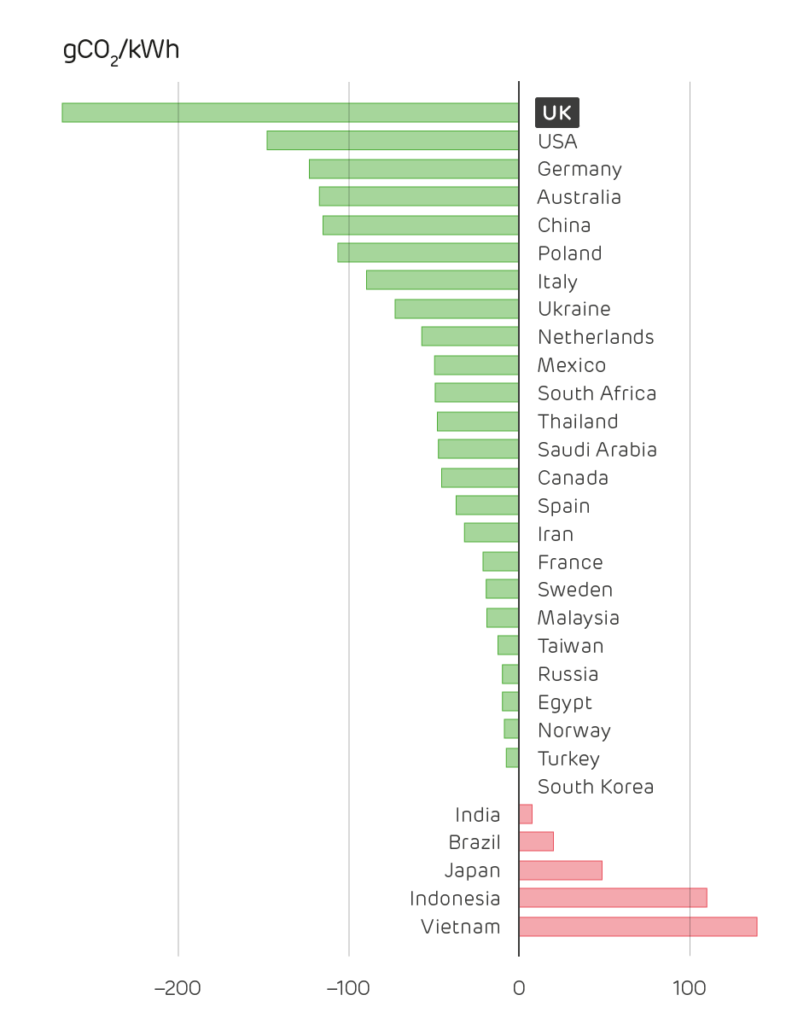
The ongoing “renewable revolution” has propelled the UK into top spot of the global decarbonisation league.
This comes as Britain is reducing its reliance on high-polluting fossil fuels in a bid to clean up the economy and reach its legally-binding net-zero emissions target by 2050.
A report by academics from Imperial College London for Drax Electric Insights shows that the UK’s electricity grid has decarbonised at a faster rate than other countries in the past decade – with emissions falling twice as quickly as in any other major economy.
Dr Iain Staffell of Imperial College London said: “The UK has decarbonised its power grid at an astonishing rate. Over the past decade, the country has transformed itself from relying on coal to keep the lights on, to having its first coal-free month since the industrial revolution.
“While this progress in the power sector has been rapid, we now need to decarbonise wider society by using electricity to heat our homes and power our cars to achieve net zero by 2050.
“As the world marks five years since the Paris Agreement, the UK offers an example of how fast energy transitions can be made.”
Renewable power in the UK has grown six-fold over past decade
The report highlights that renewable power has grown six-fold since 2010, helping the UK to cut its carbon intensity by 58%. This is double the reduction seen in other major economies over the same period.
Generation from coal fell from 30% to just 2% of power produced over the period, with renewables rising at the same time, from 8% to supplying 42% of the country’s electricity.

The changes to where Britain’s electricity comes from means that the nation’s households have each reduced their CO2 emissions by three quarters of a tonne per year compared to the start of the decade, which is roughly equivalent to the CO2 generated by a family of four taking a return flight from the UK to Spain.
As part of Prime Minister Boris Johnson’s plan for a “green industrial revolution”, the analysis notes that the UK’s power system is “set to grow even greener” after it set a new target of installing 40 gigawatts (GW) of offshore wind by 2030.
UK power grid needs to become “more flexible”
But the report also outlines the need for the UK grid to “become more flexible to deliver this ambition”, with careful management required to “keep the system stable once this ambition is realised”.
It added that upwards of 37 terawatt-hours (TWh) of excess electricity will be generated annually amid diverging weather and demand by 2030 – with wind and solar power being “unable to provide all the services needed to stabilise the system and maintain secure supplies”.
The analysis claims one solution to this challenge is to expand storage capacity by increasing the role pumped hydro storage plays in storing excess power when supply outstrips demand and then to rapidly plug gaps when the wind is not blowing, to provide “fast, flexible power and greater system stability”.
Drax said it “recognises the potential of pumped hydro storage” and is considering how its Cruachan site in Argyll and Bute, Scotland, could be expanded.
The power firm is aiming to become carbon negative by 2030 through bioenergy with carbon capture and storage (BECCS) at the Drax Power Station, in North Yorkshire.
It claims this could deliver millions of tonnes of negative emissions and simultaneously provide the grid with vital stability services while creating thousands of new jobs.



